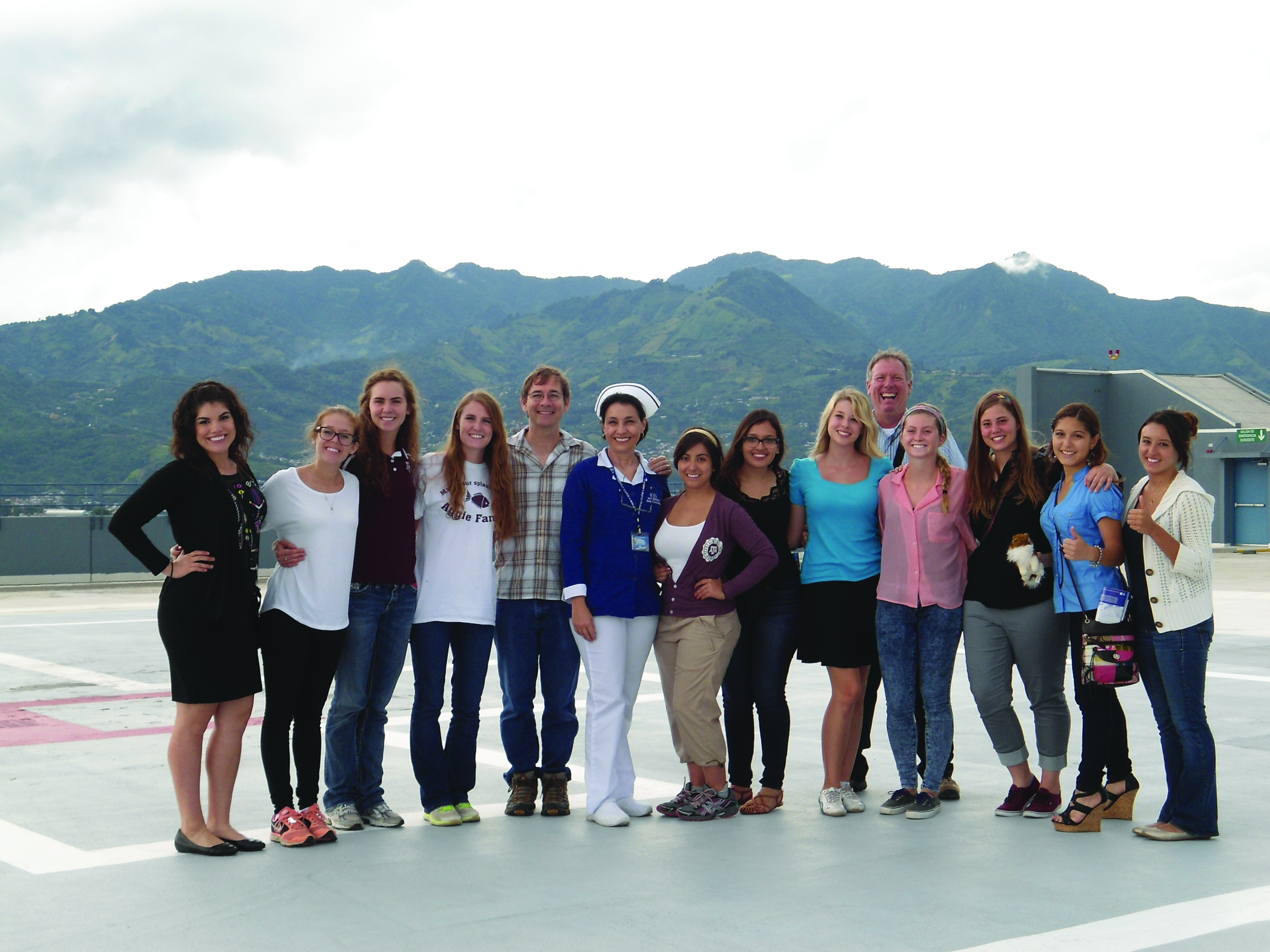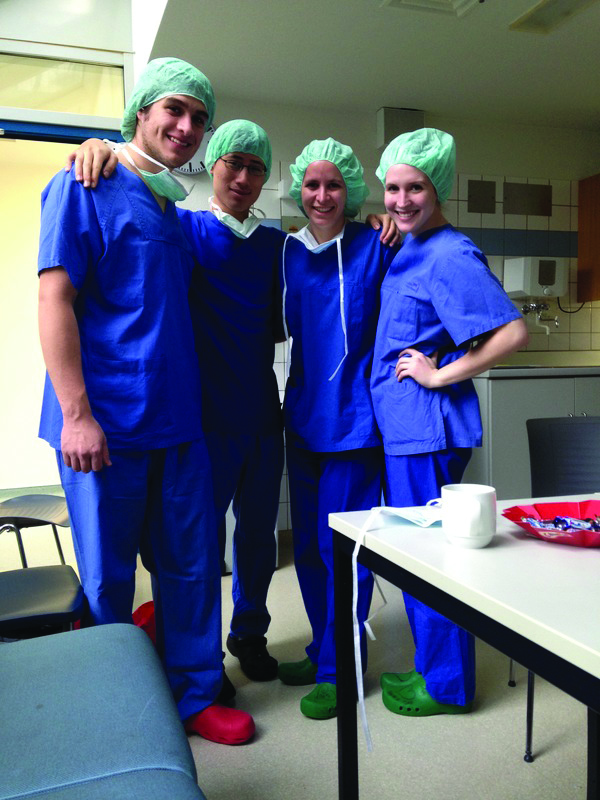International Programs at the CVM

Destiny Mullens’ favorite question to ask during her international experience in Europe was, “How many languages do you speak?” She discovered that most people with whom she talked spoke three languages, although one person spoke seven. Mullens, a senior biomedical sciences (BIMS) major, participated in a spring 2015 study abroad program in Germany, organized by the CVM’s International Programs office, where she had both an academic and cultural learning experience.
Mullens is just one of the many students whose trip was made possible by a stipend from the International Programs Advisory Committee (IPAC), housed in and composed of faculty from Texas A&M University’s College of Veterinary Medicine & Biomedical Sciences (CVM). Mullens’ experience is an example of how globalized the CVM is becoming. Her experience was possible in part due to the work of CVM’s International Programs, the mission of which is to help students and faculty to become global citizens by supporting a variety of activities including research collaborations and study abroad opportunities. Mullens’ experience was also supported by several scholarships, including the Dr. Anne Marie Emshoff ’90, DVM ’94 Scholarship from BIMS.
Over 80 percent of the $85,000 the IPAC provides annually for international opportunities goes to undergraduate, graduate, and professional students at the CVM as travel stipends. Students must apply for IPAC travel stipends to receive funding. They may use IPAC funding for two types of international experiences: faculty-led study abroad programs and independent study abroad programs the students can develop on their own with CVM approval.
However, IPAC’s efforts go beyond helping students study abroad. The committee also helps faculty develop study abroad programs and conduct international research. “It assists with providing funds if you want to establish international research partnerships or develop new study abroad opportunities,” said Dr. Christine Budke, IPAC member and associate professor in the Department of Veterinary Integrative Biosciences (VIBS).
International Learning Opportunities for Students

The CVM faculty members promote international experiences for students because they understand the value of international work. “When students go abroad, they gain culture awareness,” said Dr. Maria “Loles” Esteve-Gassent, assistant professor in the Department of Veterinary Pathobiology (VTPB), who has organized exchange programs between the CVM and Spain. “The world is a big place, both a big and a small place. There is a personal change. Some of the barriers are gone. Students aren’t afraid of new things, of change.”
“Transformative” was the word Dr. Jeremy Wasser, associate professor in the Department of Veterinary Physiology and Pharmacology (VTPP), who leads study abroad trips to Germany, uses to describe students’ international experiences. He said his goal “is to bring these students back utterly changed for good, forever.” Wasser noted the 21st century is increasingly global and students need to be comfortable working with individuals from various cultures and countries.
Dr. Elizabeth Crouch, the assistant dean for undergraduate education at the CVM, said, international experiences add depth to students’ undergraduate careers. Employers want post-graduates that work in teams and function in a world culture.
Of the BIMS students surveyed upon graduation following the 2014–2015 academic year, almost a quarter said they had participated in an international experience. Crouch added, “Every student who comes back says they would do it again.”
Study Abroad Experiences
Students can participate in a variety of experiences through the Study Abroad Programs Office at Texas A&M, as well as several faculty-led study abroad international programs through the CVM.
In one international program through the CVM, students travel to Kruger National Park and surrounding areas in South Africa to learn about chemically immobilizing, capturing, and transporting wildlife species. They work with big game, as well as plains game animals, and have the opportunity to interact with many local experts. Dr. James Derr, professor in VTPB and director of this South Africa international experience, said, “Every single day, the students have their hands on animals. For 15 days, we are darting animals, capturing animals, transporting animals, treating animals, and observing animals.” Derr continued, “The students get exposed to African veterinary medicine practices, wildlife conservation, economics, and sometimes the politics of wildlife and wildlife management.”
Veterinary students interested in learning about food safety and public health can participate in a summer short course in Italy. According to Budke, who helps coordinate the course, “The students learn about the European Union’s food safety regulatory system, which allows them to compare and contrast it with the U.S. system.” The students also interact with peers from another country who have unique perspectives and backgrounds.
Similarly, undergraduate students have analogous experiences through an international experience in Costa Rica. During this semester-long experience, students live and study at the Soltis Center. As part of the experience, students live with a host family for three weeks. “They are learning something about Latino culture, learning something about the language, and learning how to communicate as a biomedical professional in Texas,” said Dr. Don Brightsmith, assistant professor in VTPB and the director of the Costa Rica study abroad trip.
Like many study abroad opportunities, the semester in Costa Rica leads students to step outside of their comfort zone. London Dority, a student from the 2014 fall experience, said she got off the plane in Costa Rica and felt “alien in a new place. Everyone spoke only Spanish.” While in Costa Rica, she “overcame a lot of fears.” Dority couldn’t pronounce her name, when translated to Spanish, on the first day at a restaurant, but stayed with a host family for the cultural immersion. The host family welcomed her as one of their own and helped her practice Spanish over cookies and coffee in the afternoons. “The hands-on learning really helped me learn the material,” Dority said.
Spanish is also an integral component to the program in Spain, where students enroll at a local university and transfer the credits back to Texas A&M;, which is coordinated by Esteve-Gassent. The program, which emphasizes public health, is targeted to students who are interested in careers in veterinary medicine, human medicine, and public health. Specifically, the program focuses on how to communicate about global health in a different language. “It’s an immersion program,” Esteve-Gassent said. “The students need to experience what it is like to be in a different country, so they can appreciate at a different level why public health happens differently in different places.” She continued, “Cultures are different, people are different.”
Chinma Onyewuenyi, who is a medical student, participated in Esteve-Gassent’s trip to Spain as an undergraduate student, learned Spanish, and studied public health. Like Dority, she lived with a host family and experienced a cultural immersion. The program pushed Onyewuenyi to become independent. She learned to interact with people despite the language barrier and explore new places. “Just go. Go with a plan, go without a plan,” Onyewuenyi said. She encourages other students to go on an international experience and said, “because in the end, it doesn’t matter where you go or how you get there, but that you went. That’s what will change you.”
Wasser has developed experiences for both veterinary and undergraduate students in Germany. The veterinary students in the first two years of school travel with Dr. Michelle Pine, clinical associate professor in VIBS, to Europe for four weeks in the summer to experience aspects of the veterinary world in Germany and the Netherlands. Wasser leads the semester-long undergraduate experience in Germany, which has predominately BIMS and biomedical engineering students. The undergraduate program is a culturally intensive experience, including a stay with a German host family.
Students receiving IPAC funding write reports about their experiences, which can be seen at the CVM International Programs website at tx.ag/studentreports.
Internationally Diverse Graduate Programs
Students from outside the United States are encouraged to travel to the CVM for educational, research, and cultural opportunities. “While it does not financially support international students, the IPAC helps to facilitate bringing international students to the CVM. It shouldn’t be a one-way street,” Budke said. “While at the CVM these students share their unique perspectives and experiences.” Esteve-Gassent brings veterinary students from Spain to Texas A&M; for clinical rotations and culturally immerses them in American culture, expanding their views.
Dr. Linda Logan, director of International Programs since 2010 and professor in VTPB, said she is interested in “diversifying our graduate program with international students.” As of the fall 2015 semester, there were 315 international students in the veterinary and graduate programs. These students represent 26 countries, including Colombia, Germany, Iraq, Nigeria, and Japan.
Esteve-Gassent encourages graduate students to research and collaborate at the CVM. She encourages students to determine what techniques they know. Then the students can identify techniques they want to learn in a collaborative experience. Currently, the Esteve-Gassent lab has an array of people from China, Egypt, India, and Brazil.
Faculty Engagement in International Research and
Development

IPAC also supports faculty collaboration internationally. This includes research and development of new study abroad programs. International collaborative research at the CVM has centered on food security, global health, and the One Health Initiative, among others. Developing these collaborative research interests involves building international teams to obtain funding. For example, the CVM has successfully partnered with universities in Mexico to obtain Conacyt grants for collaborative research projects. The Conacyt program promotes inter-institutional research collaboration between Texas A&M and Mexican educational institutions. Conacyt projects that faculty members at the CVM are working on include studying the immune response of an endangered species of fish and improving immune responses to brucellosis.
According to Esteve-Gassent, international collaborations aren’t “something that you plan.” She explained they develop by going to meetings and talking with people. Budke said these collaborations provide unique perspectives and problem-solving approaches “that help us tackle research questions in ways that may not be evident from a single cultural viewpoint.”
Many faculty at the CVM have international collaborations. These faculty members can act as resources to consult about funding possibilities. They also provide guidance for building new collaborations and developing new study abroad opportunities. When new ideas for collaborative research or teaching opportunities arise, faculty are encouraged. Esteve-Gassent said that with new international experiences, teaching or research, “Yes you can do it, but we may not know how yet.”


